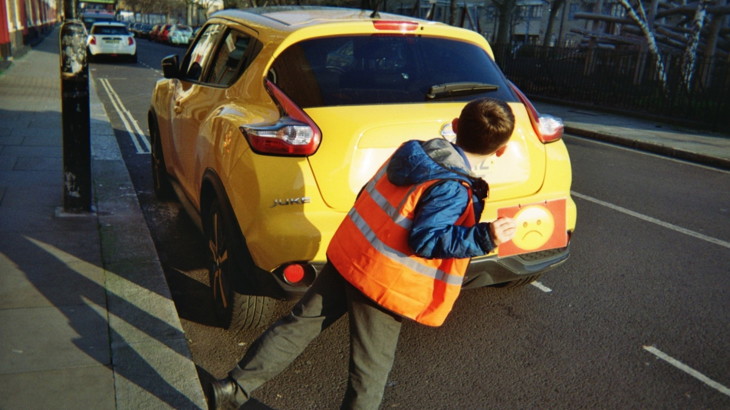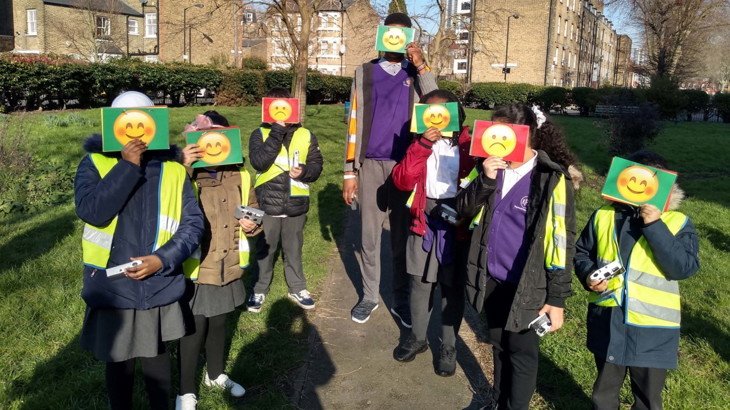We're working with Guy’s and St Thomas’ Charity as part of their programme to tackle childhood obesity. Together, we're exploring how the built environment around us can increase children’s physical activity and play.

Sustrans London are working with local communities and Southwark Council to explore what changes can be made to the streets, so children and their families feel safe to walk, cycle and play outside.
Guy’s and Thomas’ Charity saw a level of childhood obesity in the London Borough of Southwark that needed to be addressed.
They want to explore the relationship between urban design and health.
Sustrans London are working with local communities and Southwark Council to explore what changes can be made to the streets, so children and their families feel safe to walk, cycle and play outside.
Could the design of the street environment have an impact on children’s level of daily physical activity?
The main aim of the project is to help children be more active.
We want to ensure that through increased activity, children's health benefits greatly.
The charity commissioned us to find out what children wanted their streets to be like, what would make them want to spend more time outside playing and exploring where they live.
We spent time building relationships with residents. And we carried out in-depth research into how local people wanted their streets to look.
About the project
We've spread our work over five phases.
The first two phases of this project have already taken place. These are:
Phase 1: Scope and urban analysis
- We set up a steering group including Tenants’ and Residents’ Association representatives, local organisations and council officers to establish the scope of the project.
- Conducted a mapping exercise to find out more about residents’ concerns so we could work with them to come up with improvements to the streets where they live.
- Analysed building and land use, proximity to transport links, local amenities, points of interest and schools.
- Looked at the number of vehicles per day and the percentage of vehicles travelling over the speed limit.
- Recorded existing conditions by mapping street clutter, locations where it was difficult to cross, narrow pavements, and areas lacking play provision.
Phase 2: Discovery
To learn as much as possible from residents and local councillors, we ran workshops.
They focused on how we could improve the streets to reduce traffic dominance and increase children’s physical activity.
We met councillors, borough officers and community organisations to draw on local knowledge and expertise.
What the residents told us
Residents told us about the narrow pavements and parked cars.
They were concerned about traffic speed, the number of people driving through the area and dangerous crossing points.
Some highlighted problems with people on mopeds cutting through pedestrian areas.
They also talked of the lack of pedestrian crossings at public transport hubs.
Residents wanted to see wider pavements, increased play facilities for children, wayfinding, and traffic calming.
Working with the local children
We conducted school workshops and led assemblies with Keyworth Primary School, Crampton Primary School and St. Paul’s Primary School.
This got the children and their parents thinking about how they wanted their streets to look.
Street Stars
We set up child-led project ambassador groups called the Street Stars.
They told us what changes they would like to see to make it easier, safer and more enticing to travel actively and play outside.
We also:
- Organised child and adult-led walking audits.
- Asked the children to map their journeys to school, green spaces, places they don’t like to go and where they were and weren’t allowed to go, as well as spaces where they play.
- Introduced them to the Healthy Street indicators TM and asked them to rate the streets near their school. The children held up emoji cards showing a happy, neutral and sad face. This made it easy for them to tell us what liked and didn’t like about their streets.
- Ran ‘Design a child-friendly street’ competitions to encourage the children to consider how they would make their neighbourhoods healthier and more fun. They wanted painted street games, play equipment, trees and flowers, no through traffic or parked cars and areas to relax.
Data Analysis
Our Research and Monitoring experts helped us to identify locations to focus on during our co-design phase.

Children in Southwark working with us on child-led street design.
What's next?
We're now moving on to the next three stages to complete this project. These are:
Phase 3: Co-design
Our design team are ready to work with residents, including children, and councillors, to create design solutions to the issues they raised in the Discover phase.
Ideas include strategies to address traffic dominance, safer crossing points, routes to greenspaces, ‘play on the way’ features on key walking routes and wayfinding.
We are working alongside Southwark Council to ensure the child-friendly project works in conjunction with the council’s Our Healthy Walworth scheme to reduce the dominance of motor traffic.
Phase 4: Test
We always aim to set up temporary street infrastructure to thoroughly test out early proposals developed in the co-design phase.
The Test phase is an interactive process where residents are able to feed back their thoughts on the designs before they are finalised by the council.
Phase 5: Deliver
This is when we work with the council to install the infrastructure that is agreed with the local community and the council.
After the changes have been made to the streets, we will monitor the impact of the changes to the local area.
To do this, we will use video monitoring looking at the street space before and after the intervention has been put in place, which will help us to understand whether more physical activity has been enabled.
Continuing our work in Southwark
Working in constructive partnerships like this helps us to create design proposals which both support the council’s plans and meet the needs of communities.
We will be updating this page as the project progresses.
How you can get involved
If you would like to be involved in this project or find out more information, please email us at CollaborativeDesign@sustrans.org.uk.





